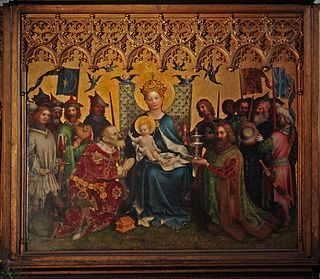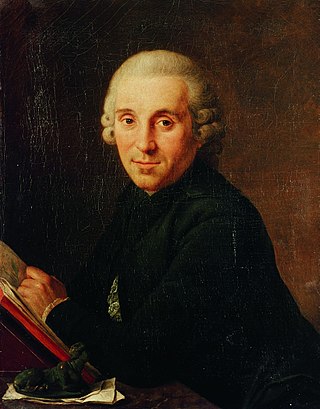
The Great Saint Martin Church is a Romanesque Catholic church in Cologne, Germany. Its foundations rest on remnants of a Roman chapel, built on what was then an island in the Rhine. The church was later transformed into a Benedictine monastery. The current buildings, including a soaring crossing tower that is a landmark of Cologne's Old Town, were erected between 1150-1250. The architecture of its eastern end forms a triconch or trefoil plan, consisting of three apses around the crossing, similar to that at St. Maria im Kapitol. The church was badly damaged in World War II; restoration work was completed in 1985.

The Master of the Saint Bartholomew Altarpiece was an Early Netherlandish painter active in Germany, mostly Cologne, between 1475/1480 and 1510. Despite his anonymity, he is one of the most recognizable artists of the early Renaissance period in German art.

The Grand-Ducal Saxon Art School, Weimar was founded on 1 October 1860, in Weimar, Germany, by a decree of Charles Alexander, Grand Duke of Saxe-Weimar-Eisenach. It existed until 1910, when it merged with several other art schools to become the Großherzoglich Sächsische Hochschule für Bildende Kunst. It should not be confused with the Weimar Princely Free Drawing School, which existed from 1776 to 1930 and, after 1860, served as a preparatory school.

Herbert Hoffmann was a German tattoo artist and photographer.

The term Cologne School of Painting was first applied in the 19th century to describe old German paintings generally. It subsequently came to refer more specifically to painters who had their workshops in medieval Cologne and the lower-Rhine region from about 1300 to 1550.

Wilhelm Lambert Krahe was a German history painter and art collector.

Ferdinand Franz Wallraf was a German botanist, mathematician, theologian, art collector and Roman Catholic priest. His collection formed the founding nucleus of the Wallraf–Richartz Museum.
Bettina Baumgärtel is a German art historian who is head of the painting collection of the Museum Kunstpalast in Düsseldorf. She is a leading authority on the art of Angelica Kauffman and founded the Angelika Kauffmann Research Project (AKRP), of which she is the director, in 1990.
Michael Bacht is a German artist.
Ulrich Schulte-Wülwer is a German art historian, specializing in north German painters of the 19th and 20th centuries.
Wolfgang Kermer is a German art historian, artist, art educator, author, editor, curator of exhibitions, art collector and professor. From 1971 to 1984 he was repeatedly elected Rector of the State Academy of Fine Arts Stuttgart and thus the first scientific and at the same time youngest teacher in this position in the history of the university. Under his rectorate, the State Academy of Fine Arts Stuttgart was reformed in 1975 and 1978 on the base of two new university laws of the State of Baden-Württemberg and thus, for the first time in its history, authorized to set up diplomas for all courses. One of the accents of his work was the promotion of talented graduates of the academy: In 1978 he organized the first of the so-called ″debutant exhibitions″, an ″unconventional contribution to the promotion of young people″, supported financially by the State of Baden-Württemberg.

The Master of the Holy Kinship the Younger is a German painter of the Middle Ages who was active between 1475 and 1515 in Cologne and its environs. He is designated "The Younger" to distinguish him from another Master, given the same name, who worked in that area from 1410 to 1440.

The Master of the Wasservass Calvary is the notname for a painter active in Cologne between 1415 and 1435. He is relatively unusual in Cologne art of his time, owing more to Burgundian manuscript illuminating and Early Netherlandish painting of the time.
Bodo Balthasar von Dewitz was a German art historian. His work focused on historical photography.
Hans Wilhelm Hupp (1896–1943) was a German art historian, author and curator. From 1933 to 1943 he directed the Museum Kunstpalast of the city of Düsseldorf..

Katja Terlau is a German art historian and provenance researcher. She was a co-initiator and founding member of the international Arbeitskreis Provenienzforschung in Germany, founded in 2000 and is considered a pioneer of German Provenance Research, which she entered after the Washington Principles on Nazi-Confiscated Art of 1998. Her main subject area is looted art; a number of museum holdings and large Jewish collections have been processed by her.
Max Creutz was a German art historian and curator of the Museum für Angewandte Kunst Köln and the Kaiser-Wilhelm-Museum in Krefeld where he worked from 1922 until his death. In Cologne, in 1914 he was instrumental in the first exhibition of the Deutscher Werkbund, Deutsche Werkbundausstellung. In Krefeld, he succeeded in acquiring modern art exhibits, including works by Max Ernst, Wassily Kandinsky, and Alexej von Jawlensky. He included a substantial collection of art, crafts and design from the Bauhaus.
Rolf Fritz was a German art historian. His research focused on German art from the Middle Ages to the 19th century, especially on the art and cultural history of Westphalia, as well as on various genres of arts and crafts.

The Master of the Legend of Saint Bruno is the "notname" of an anonymous Gothic painter who was active in Cologne in the late 15th century. He is best known for the cycle of paintings on canvas produced for Cologne Charterhouse after which he is named.

Margarete Oppenheim was a German art collector and patron. She was among the first personalities to collect works of modern art in Germany and owned one of the largest collection in Germany.












